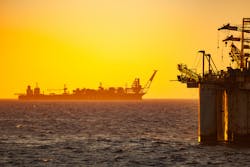Offshore staff
HOUSTON – The world’s FPSO fleet is getting older. Fifty-five FPSO units in the global fleet are reaching the end of their design life in the next five years, according to ABS; and a further five have life extension in place, with 19 more currently being evaluated for life extension.
To address the possible safety issues that could arise from corrosion and other structural integrity concerns, ABS recently created a working group comprised of major players in the FPSO marketplace.
The ABS-led working group includes Chevron, Shell, Petrobras, MODEC, and SBM Offshore, as well as the Bahamas Maritime Authority, the Republic of the Marshall Islands Registry, and the US Coast Guard 8th District. The group has created five joint industry projects (JIPs) aimed at using technology to tackle a range of FPSO safety issues.
The JIPs will tackle composite materials repairs for offshore structures; life extension of wire ropes; gauging management software; applications of photogrammetry and 3D Lidar laser scanning; and the role of artificial intelligence in corrosion analysis.
“ABS classes over 60% of the global FPSO fleet, so we are intricately connected to the global FPSO fleet and its overall health,” said Matthew Tremblay, Senior Vice President—Global Offshore Markets for ABS. Tremblay met with Offshore magazine at OTC 2021 in Houston to discuss the goals of the working group, and the early efforts of the JIPs.
“As the FPSO fleet ages, we wanted to sit down and talk with the operators and major manufacturers and see if we could identify the risks that are specific to aging FPSOs that weren’t being adequately addressed to date,” Tremblay explained. “We wanted to determine if there are means available of mitigating those risks, and to see if there are any tangible actions that we could initiate as a group to make sure that the risks posed by aging FPSOs was as low as possible.”
For example, Tremblay noted that many wire rope mooring systems have been in the field for 20 years, and as such are approaching the end of their design life. “And so now we have to try and determine whether they are still suitable for continued service and life extension,” Tremblay explained. “It’s a real challenge: how do we take a wire rope that’s been in service for the past 20 years, take it out of service, chop it up and look at the inside? It’s an expensive exercise. So that JIP is looking into what types of systems are available to evaluate the condition of these wire rope mooring systems.”
Another JIP will look into the use of laser scanning, photogrammetry and artificial intelligence to detect and analyze corrosion. “ABS produced an AI tool last year that looks at photos of structures, and evaluates the percentage of corrosion in that structure,” Tremblay noted. “That AI tool can project corrosion rates based on image analysis, and it has been shown to have equal or better accuracy than a human expert could offer. So what we need to do now is give the AI more practice and give it more images and more opportunities to be trained.”
In the near term, Tremblay says that the working group will continue to oversee the efforts of the JIPs and assist them with their missions. The working group has also identified over 40 changes to the ABS class rules regarding FPSOs, and “we are going to implement these over the next year to try and reduce risks related to aging FPSOs,” Tremblay said. The working group will also continue to work toward publication of new best practices documents regarding FPSO maintenance and inspection.
08/19/2021



